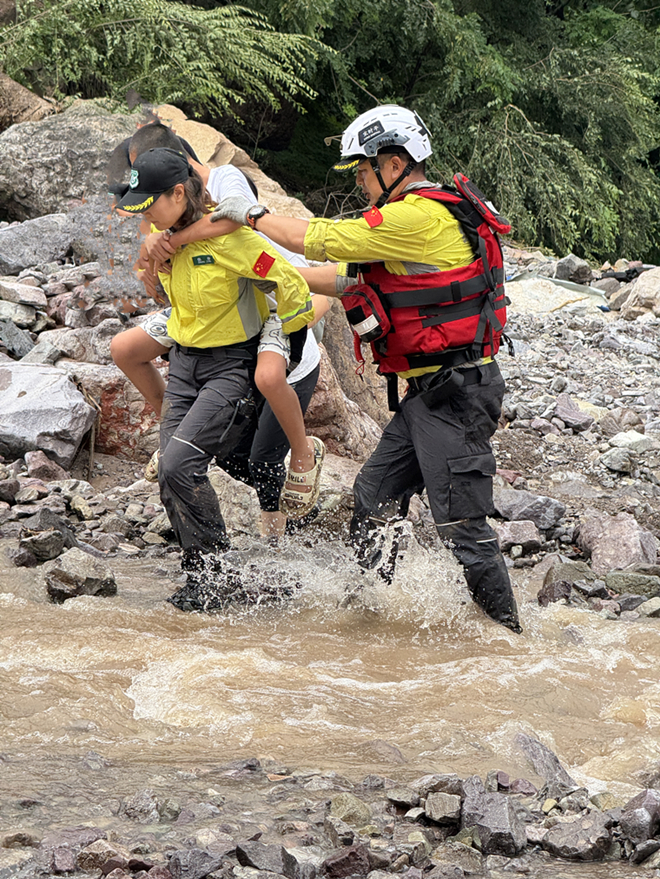At 3 a.m. on July 27, Zhang Jing’s phone screen lit up and then dimmed again as text message notifications kept coming in. The Beijing Green Boat Rescue Team work group had issued a new task—heading to the mountainous areas to evacuate affected villagers. Volunteers were asked to sign up.
Zhang Jing had already seen the news: starting from July 26, an extreme rainstorm had caused severe disasters in mountainous regions such as Miyun, Huairou, Yanqing, and Pinggu. “I’ll go,” she signed up without hesitation.
Though Zhang Jing had previously participated in searches for lost hikers, this was her first time responding to a disaster scene.
Normally, Zhang Jing works in an office building, handling online tasks. She had always wanted to help others. Later, she joined the Beijing Green Boat Rescue Team as a special operations member. “Being able to volunteer outside of work and contribute in my own small way to help those in need makes me very happy.”
From the floods in Zhuozhou, Hebei, to earthquakes in Dingri, Tibet, and Myanmar—despite being a “newcomer” with just over a year in the team, she always responded immediately whenever a mission arose.
Zhang Jing wanted to be like her male teammates—”going on missions, working on the front lines”—but she knew that enthusiasm alone wasn’t enough. There was still a significant gap between her skills and the rescue expertise required in disaster zones.
Even as a female team member, Zhang Jing refused to be a burden. She trained hard in rope rescue techniques, water rescue skills, emergency first aid, and casualty transport, always ready to enter the “battlefield.”
“This time, my own city was affected, and I was confident in my ability to traverse the mountains, so I actively requested to join the mission,” Zhang Jing said.
At 5 a.m. on the 27th, she arrived on time at the assembly point and set off with the Green Boat Rescue Team to Liulimiao Town in Huairou. Zhang Jing was the only female rescuer on-site.
In her free time, Zhang Jing enjoys cycling and had ridden through Huairou many times. The mountain roads were as elegant as ribbons, with picturesque scenery along the way—a “poetic escape” for city dwellers.
But after the storm, the scene was shocking: asphalt roads had been torn apart, chunks of pavement scattered like cookies, fallen trees and power lines blocking the way… Vehicles could no longer pass.
“We need to proceed on foot immediately to search for trapped individuals.” Seven members of the Green Boat Rescue Team formed an emergency response unit, carrying equipment as they advanced along the winding mountain road toward Liulimiao Town. The storm had disrupted communication signals, cutting off contact with the command center.
Mudslides and landslides made the path treacherous. The team trudged through knee-deep mud, with Zhang Jing carrying 20 pounds of gear. Each step required planting one foot firmly in the mud, pulling the other out, and repeating the exhausting process.
Some bridges had collapsed, with massive boulders blocking the way—forcing them to climb like mountaineers. In other places, the road had been washed away, leaving only steep cliffs on one side and raging rivers on the other. They set up ropes and inched along the rock face, knowing one misstep could send them plunging into the floodwaters.
Male teammates offered to carry Zhang Jing’s pack to lighten her load, but she firmly refused. When a teammate was injured, Zhang Jing, responsible for medical support, quickly retrieved antiseptic and bandages from her bag to treat the wound.
“There was no time to rest—we wanted to reach our destination as quickly as possible,” Zhang Jing said. “Even bathroom breaks were difficult, so I drank only small sips of water to stay hydrated.” Working closely with her team, she pushed forward to villages near Huangtuliang and Gezidong Bridge to search for survivors.
By 4:30 p.m., the emergency unit reached their destination—Yushuidong Village—to evacuate stranded villagers.
With the road into the village destroyed, the team split into two groups. One group built a makeshift bridge at the village entrance using ladders and wooden planks, waiting to assist evacuees. Zhang Jing and another teammate entered the village, going door-to-door to persuade residents to leave.
Zhang Jing saw houses with walls washed away. Most remaining villagers were elderly or children—some as old as 90, others as young as two months.
Many elderly residents



